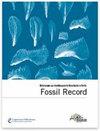下载PDF
{"title":"Conserved bone microstructure in the shells of long-necked and short-necked chelid turtles (Testudinata, Pleurodira)","authors":"Torsten M. Scheyer","doi":"10.1002/mmng.200800009","DOIUrl":null,"url":null,"abstract":"<p>Extant and fossil chelids are restricted to South America and Australasia. Based on morphological data, long-necked and short-necked chelids are hypothesised to form natural groups respectively, whereas molecular and serological data indicate South American and Australasian chelids are monophyletic, regardless of neck-length. Here I provide shell bone histological and microanatomical data and character mapping of seven chelid taxa and the Late Jurassic stem-pleurodiran <i>Platychelys oberndorferi</i> Wagner, 1853 to test both competing hypotheses. The chelid shells show conserved bone microstructures, many of which are plesiomorphic for all turtles. Part of the variation among chelid shell microstructures could be attributed to functional aspects associated with the ecology of the taxa, i.e. adaptation to an aquatic lifestyle. The character mapping further indicates that the hypothesis of clades based on neck length is supported by two synapomorphies (i.e., parallel-fibred bone grading into lamellar bone in internal cortex and vascularisation of internal cortex) and one less tree step (16 instead of 17) in contrast to the molecular-based separation based on geographic distribution. (© 2009 WILEY-VCH Verlag GmbH & Co. KGaA, Weinheim)</p>","PeriodicalId":55147,"journal":{"name":"Fossil Record","volume":"12 1","pages":"47-57"},"PeriodicalIF":2.1000,"publicationDate":"2009-02-20","publicationTypes":"Journal Article","fieldsOfStudy":null,"isOpenAccess":false,"openAccessPdf":"https://sci-hub-pdf.com/10.1002/mmng.200800009","citationCount":"20","resultStr":null,"platform":"Semanticscholar","paperid":null,"PeriodicalName":"Fossil Record","FirstCategoryId":"89","ListUrlMain":"https://onlinelibrary.wiley.com/doi/10.1002/mmng.200800009","RegionNum":4,"RegionCategory":"地球科学","ArticlePicture":[],"TitleCN":null,"AbstractTextCN":null,"PMCID":null,"EPubDate":"","PubModel":"","JCR":"Q3","JCRName":"Earth and Planetary Sciences","Score":null,"Total":0}
引用次数: 20
引用
批量引用
Abstract
Extant and fossil chelids are restricted to South America and Australasia. Based on morphological data, long-necked and short-necked chelids are hypothesised to form natural groups respectively, whereas molecular and serological data indicate South American and Australasian chelids are monophyletic, regardless of neck-length. Here I provide shell bone histological and microanatomical data and character mapping of seven chelid taxa and the Late Jurassic stem-pleurodiran Platychelys oberndorferi Wagner, 1853 to test both competing hypotheses. The chelid shells show conserved bone microstructures, many of which are plesiomorphic for all turtles. Part of the variation among chelid shell microstructures could be attributed to functional aspects associated with the ecology of the taxa, i.e. adaptation to an aquatic lifestyle. The character mapping further indicates that the hypothesis of clades based on neck length is supported by two synapomorphies (i.e., parallel-fibred bone grading into lamellar bone in internal cortex and vascularisation of internal cortex) and one less tree step (16 instead of 17) in contrast to the molecular-based separation based on geographic distribution. (© 2009 WILEY-VCH Verlag GmbH & Co. KGaA, Weinheim)
长颈龟和短颈龟(鳖亚纲,鳖亚纲)壳中保存的骨微观结构
现存的和化石的chelids仅限于南美洲和大洋洲。根据形态学数据,长颈和短颈的chelids被假设分别形成自然类群,而分子和血清学数据表明,南美和澳大利亚的chelids是单系的,与颈部长度无关。在这里,我提供了7个chelid分类群和晚侏罗世茎-pleurodiran Platychelys oberndorferi Wagner, 1853年的壳骨组织学和显微解剖学数据和特征映射,以测试两个相互竞争的假设。螯壳显示出保守的骨微结构,其中许多是所有海龟的半胚性。螯虾壳微观结构的部分差异可归因于与该分类群生态相关的功能方面,即对水生生活方式的适应。特征映射进一步表明,与基于地理分布的基于分子的分离相比,基于颈部长度的进化支的假设得到了两个突触的支持(即,平行纤维骨在内皮层分级为板层骨和内皮层的血管化),并且少了一个树阶(16而不是17)。(©2009 WILEY-VCH Verlag GmbH &KGaA公司,Weinheim)
本文章由计算机程序翻译,如有差异,请以英文原文为准。


